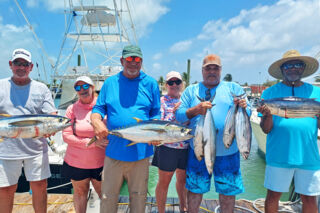Turks and Caicos Fishing Guide

The Turks and Caicos features a healthy and pristine marine environment, and consequently, the fishing is excellent.
The islands offer the perfect setting for several types of sport fishing. The Atlantic depths and great deep-sea fishing is only minutes away. The shallow and turquoise Caicos Banks also support incredible bonefishing, and we have extensive barrier reefs for bottom fishing.
There’s a wide array of fishing tours and charters to choose from across our islands. Anyone can begin fishing, and our local companies cater to both pros and amateurs. Small vessels are the norm in the Turks and Caicos, and depending on the type of fishing and your group size, you may have the entire boat to yourselves.
For those visiting Pine Cay or Parrot Cay, fishing charters on Providenciales are located a short distance away and offer pick up and drop off to the islands’ docks.
The selection of fishing charter businesses varies greatly on each of our islands. See island-specific and location details below.
Fishing Licenses and Limits
- All visitors 16 and older must have a fishing license when fishing in the Turks and Caicos. Children under 16 do not require a fishing license.
- Most fishing charter companies either include licenses with their charters, or are able to sell licenses at minor cost.
- 1-day and 30-day fishing licenses are available across Providenciales, including at all primary marinas.
- 1-day fishing licenses cost $10 from government offices that provide them, and $10-15 from marinas, charter companies, and other businesses that supply fishing licenses.
- 30-day fishing licenses cost $30 from government offices that provide them, and $30-35 from businesses.
- Issuers of fishing licenses will need to see government-issued photo ID of applicants.
- A person holding a recreational fishing license is allowed to keep 10 pounds (4.5 kg) of fish (which may be cleaned), and one ‘trophy fish’ (which may exceed 10 pounds or 4.5 kg in weight), per day.
- Generally, most edible fish must be at least 6 inches in length to be kept. In the Turks and Caicos, Nassau grouper has a fishing season, which is typically open from March to November. It is illegal to be in possession of Nassau grouper outside of the season.
Island-Specific Fishing Guides
Fishing Charter or DIY Shore Fishing?

It’s possible to either fish from shore, or take a boat excursion. Generally, a fishing charter will offer a much better chance of a great catch.
Decent locations can be found on land for bottom fishing and flats fishing. See the island-specific pages for detailed location information and directions.
There are no suitable rental vessels for self-captained fishing.
Deep-Sea Sport Fishing and Game Fishing
The Turks and Caicos features perfect geography for deep-sea sport fishing. Our islands are situated on a submerged plateau, and the edge of the plateau and deep Atlantic isn’t far off our islands. On Providenciales and Grand Turk, you’ll often be in water that’s over 5000 feet (1500 m) deep in only minutes.
This water sport utilizes purpose-built sport trawlers, many of which offer luxurious cabins and amenities.
There are often the ocean surface indicators of seabirds to suggest where the catch may be. As the game fish attack schooling pelagic fish, the birds feast on scraps that float to the surface. Part of the day’s adventure is scanning the horizon for the commotion.
It definitely takes a bit of stamina to reel in a big fish, yet local charter companies will work with almost anyone who wants to try their hand, and there’s always the crew to assist if necessary.
The common practice for billfish such as blue marlin and sailfish is to catch-and-release. Edible species such as tuna, wahoo, and mahi-mahi are chilled and brought back for dinner.
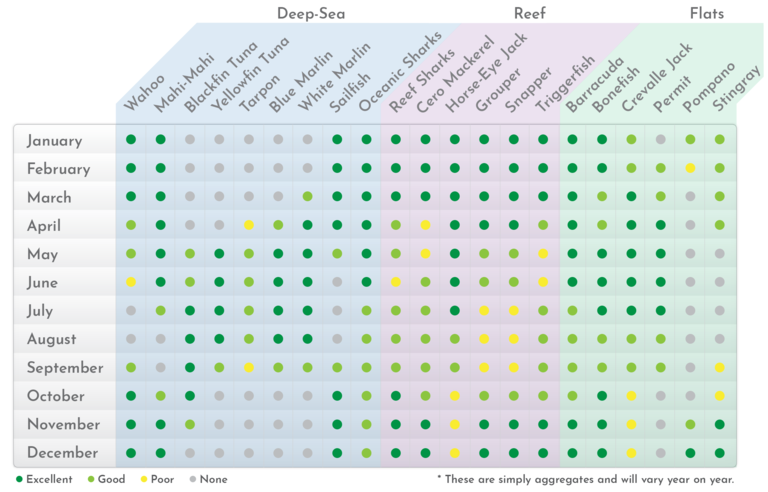
Bonefishing and Flats Fishing

Bonefishing is increasing in popularity in the Turks and Caicos, and with good reason. The extensive Caicos Banks hides some of the finest flats fishing in the tropical Atlantic.
The best bonefishing locations are hidden in the maze of shoals and channel fronting the southern wetlands of North Caicos, Middle Caicos, and East Caicos. The common catch includes bonefish, barracuda, and tarpon. The common local bonefish is 4-5 lbs (1.8-2.2 kg), yet they can exceed 12 lbs (5.45 kg).
Serious flats fishers will probably be best served by staying on the island of South Caicos. This quiet destination doesn’t see much tourism, yet it’s within close access to expansive sounds and flats that see very few visitors.
On Providenciales, fishing vessels used in the flats are typically flat-bottomed skiffs with platforms. On South Caicos, there are a few airboats in addition to the skiffs.
The typical and ideal bonefish flat in the Turks and Caicos is quite shallow, and wading is an option for those that prefer it to fishing from the boat’s platform.
Flats fishing is typically great throughout the year, yet the summer and autumn months probably have the edge. This period coincides with the Atlantic hurricane season, which has a small chance of disrupting your vacation.
The dedicated bonefishing tour companies maintain a range of all necessary equipment, including rods, flies, tackle, and line, if you’d rather not bring your own gear. 7 to 9 weight rods are the recommended size.
Successful bonefishing requires a bit of skill and experience, yet everyone has to start somewhere. If you’re looking to learn or hone your skills, lessons are available from our local guides. Don’t forget to bring your polarized sunglasses!
One type of flats fishing that’s gaining in popularity is fishing by stand-up paddleboard. This eco-friendly means of transport allows for access into some of the best spots and waterways in the country.
Reef and Bottom Fishing
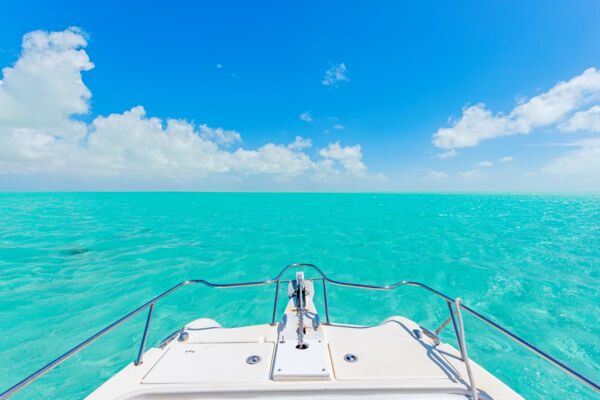
Reef and bottom fishing is the classic form of the water sport, and its founding purpose was simply to put food on the table. Today, the sport serves the same function, yet has evolved.
Reef fishing is the easiest genre of fishing, and doesn’t require much strength or experience. Because of this, it’s a great choice for families and kids.
The catch often includes Nassau grouper, red snapper, mutton snapper, gray snapper, yellowtail, horse-eye jack, permit, and barracuda.
Great fishing spots can be found throughout the Turks and Caicos, yet also vary greatly according to the season, weather conditions, and the tide. There are many great local captains and guides, with invaluable experience gained from years on the water.
Lobster and Conch Fishing
If you’d like to try your hand at diving for conch and lobster, the activity may be offered on some of the island hopping and boat charter excursions. These marine bottom dwellers are typically found in water ranging from wading depth to about 40 feet (12 m).
Both conch and lobster have applicable fishing seasons. Be aware of protected areas where the collecting of conch and lobster is prohibited. The conch fishing season is usually open from November to mid-July, and the lobster season is typically August through March, however, be advised that this varies each year.
National Parks
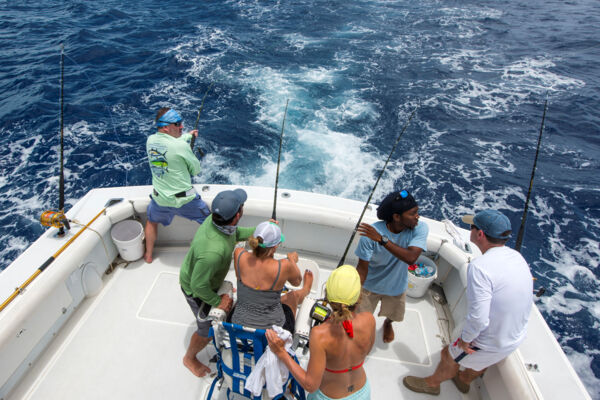
The Turks and Caicos has a wonderful selection and range of national parks and protected areas, both marine and terrestrial. Fishing is generally prohibited in such regions, wherein it is a criminal offense to fish or collect conch, lobsters, or shells.
Many of the popular coastlines and beaches on Providenciales, Grand Turk, and South Caicos are inside a national park or nature reserve. This includes Grace Bay Beach and nearly all of Leeward Beach.
If you fish on your own, it’s your responsibility to be aware of regulations and protected areas. See Providenciales National Parks, Columbus Landfall National Park (Grand Turk), Admiral Cockburn Land and Sea National Park (South Caicos), and the Ramsar Nature Reserve (North Caicos and Middle Caicos).
Shark Fishing
Shark and ray fishing is legal in the Turks and Caicos Islands, however, there have been plans to restrict this. Proposals include banning the ‘commercial exploitation’ of sharks and rays in the EEZ (Exclusive Economic Zone) of the TCI, where the seabed depth is greater than 100 meters (around 300 feet).
Booking and Reservations
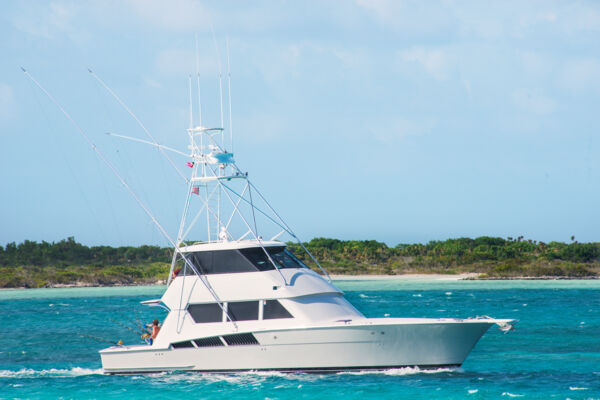
Bookings are typically made directly with the fishing company.
Like many vacation destinations, the Turks and Caicos sees predictable rises and falls in tourism arrivals throughout the year. Availability of accommodations and attractions may be limited during the winter “high season”, and rates are lowest during the late summer and autumn months.
This is especially a consideration for flats fishing and deep-sea sport fishing, as there’s a limited number of suitable vessels for these activities. See Best Times to Visit.
Drinks, snacks, and refreshments are usually complimentary on fishing expeditions, as is the common case with most boat charters. On longer tours, lunch is typically included as well.
The 12% government tourism tax is applicable to fishing and many other activities, and may or may not be included in quoted rates.
Cancellations
If a cancellation is made within a few days of a trip’s scheduled departure, a half or full rate may be charged as the tour company will likely be unable to rebook the time slot.
Canceled excursions due to poor weather are typically not charged.
Clarify the cancellation policies with your chosen business before booking.
Fresh Fish and Dinner
In addition to the excitement of the catch, another positive of fishing is an exquisite dinner.
If your accommodation has a kitchen, you can of course cook the catch yourself, yet those who may not want to have the option of having a local restaurant prepare the catch, or arranging the services of a Turks and Caicos private chef.
If you’re looking to stock up on complementing ingredients, see supermarkets and grocery stores.
The Turks and Caicos consists of small islands, and we don’t have any rivers, intensive agriculture, factories, or heavy industry to pollute the ocean, so our marine life is some of the safest in the world.
Imported Fish
It may be difficult to believe considering that we’re a tropical island nation, yet quite a bit of seafood is actually imported into the Turks and Caicos.
This is largely due to two factors: the locally mandated small-scale commercial fishing industry results in higher fish prices, and we have fishing seasons for various species to reduce environmental impact.
Many of the truly local restaurants, such as Mangrove Bay Restaurant, pride themselves in their sole use of freshly caught seafood, which is definitely noticeable in the dishes. You’ll know you’re at an authentic establishment when you’re told that there’s no fish on the menu due to “bad weather” or “bad catch”!
Imported fish carries a rather high customs duty rate of around 40%, yet despite this, imported fish is often less expensive than fresh-caught, and may be what’s served at many eateries.
Fishing Licenses
A valid fishing license must be held by visitors 16 and older when fishing in the Turks and Caicos. Children under 16 do not need a fishing license.
Visitors must be in possession of a valid fishing license before attempting to fish. On fishing vessels, all adults must hold valid fishing licenses, even those not actively fishing.
1-day fishing licenses cost $10-15. 30-day fishing licenses cost $30-35. The issuer of the fishing license will need to see government-issued photo ID of the applicant.
Fishing charter and excursion businesses will typically arrange fishing licenses for their guests. In such cases, fishing licenses may incur additional fees on top of charter costs.
If you’re fishing on your own, it’s your responsibility to obtain a license. These may be purchased from most marinas, including Turtle Cove Marina and Heaving Down Rock Marina (Walkin Marina), and from Walkin Marine, a fishing and boating supply shop located near Downtown and Blue Hills on Providenciales.
| Fishing License Fees | |
| Day | $10 |
| Month | $30 |
| Year | $60 |
Prohibited Fishing Practices
Fishing with spear guns is illegal in the Turks and Caicos. Hawaiian slings are not permitted for recreational fishing. With the sole exception of the invasive lionfish, it is illegal to collect any marine product while using scuba equipment, including conch and lobster.
Fishing, Tackle, and Bait Shops

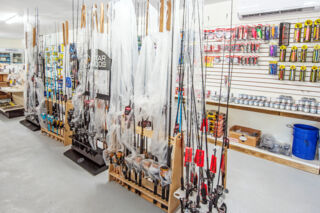
Fishing Charters


